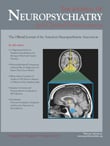Deliberate Insulin Underdosing and Omission Should Be Included in DSM-V Criteria for Bulimia Nervosa
To the Editor: Fourteen percent of young women with insulin-dependent diabetes mellitus (IDDM) deliberately omit or underdose their insulin in order to lose weight, as do 50% of women with IDDM and an eating disorder. 1 The first case reports of this behavior appeared in 1983. 2 It is called “diabulimia” in diabetic textbooks 3 and in the lay media. The Yahoo search engine reveals over 100,000 hits for diabulimia including blogs, newspaper/magazine articles, and TV shows. The American Psychiatric Publishing Textbook of Consultation-Liaison Psychiatry4 and the text of DSM-IV mention skipping insulin doses, but neither it nor “diabulimia” is included in the American Psychiatric Publishing Textbook of Clinical Psychiatry , 5 the Kaplan and Sadock’s Comprehensive Textbook of Psychiatry , 6 or DSM-IV criteria for bulimia nervosa. We are unaware of any articles in psychiatric journals that use the word “diabulimia.” We report a case of diabulimia in which the patient underdosed or omitted doses of insulin by disconnecting her insulin pump.
Case Report
An endocrinologist referred a 22-year-old woman with IDDM to our psychiatry clinic because of her bulimia, anxiety, and depression. She started bingeing four to five times a week during her sophomore year of college. She felt out of control and decided to disconnect her insulin pump overnight after bingeing. She reasoned that omitting insulin would cause the same weight loss she experienced in high school before she was diagnosed with IDDM. Unhooking her pump partially reduced her anxiety about gaining weight, but her hemoglobin A1c climbed from 7% to 16%, and guilty and embarrassed by her behavior, she avoided her family and her endocrinologist.
We diagnosed her with bulimia nervosa, with disconnection of her insulin pump counted as the “inappropriate compensatory behavior” needed for this diagnosis. We prescribed both low dose clonazepam to help with her anxiety and poor sleep and weekly psychotherapy for bulimia and depression. She responded to graduated exposure techniques to decrease her postbinge anxiety and the frequency of disconnecting her insulin pump. She learned to challenge cognitive distortions (e.g., that bingeing was a reward and that her life was better when she was thinner). During therapy, she practiced telling her family and friends about her disorder, and her guilt, isolation, and anxiety declined quickly after she shared her “secret” with them. She stopped disconnecting her insulin pump although she still has occasional thoughts of restarting her diabulimic behavior. Her mood was stable and euthymic at her 3- and 6-month follow-up appointments. She has kept her regular appointments with us and with her endocrinologist, and her hemoglobin A1c has steadily improved.
Comment
We urge the specific inclusion in DSM-V of insulin misuse, as occurs in ICD-10, among the recurrent inappropriate compensatory behaviors to prevent weight gain in bulimia nervosa. DSM-IV lists only “laxatives, diuretics, enemas, and other medications.” DSM-V should use the word “diabulimia” in discussing insulin omission—by stopping injections, by underdosing, or by turning off insulin pumps—in the body of text on bulimia. Although our patient did not suffer any serious medical problems, the acute consequences of diabulimia include ketoacidosis and death, while chronic consequences include nephropathy, neuropathy, and retinopathy. 7
1. Rodin G, Olmsted MP, Rydall AC, et al: Eating disorders in young women with type I diabetes mellitus. J Psychosom Res 2002; 53:943–949Google Scholar
2. Hillard JR, Hillard PJA: Bulimia, anorexia nervosa, and diabetes: deadly combinations. Psychiatr Clin North Am 1984; 7:367–379Google Scholar
3. Brink S: Insulin therapy and home monitoring for type 1 diabetes mellitus, in Diabetes Mellitus: A Fundamental and Clinical Text, 3rd ed. Edited by Leroith D, Taylor SI, Olefsky JM. Philadelphia, Lippincott Williams & Wilkins, 2003, pp 498–499Google Scholar
4. Wise M, Rundell J (eds): The American Psychiatric Publishing Textbook of Consultation-Liaison Psychiatry, 2nd ed. Washington, DC, American Psychiatric Publishing, 2002, pp 477–493Google Scholar
5. Hales R, Yudofsky S (eds): The American Psychiatric Publishing Textbook of Clinical Psychiatry, 4th ed. Washington, DC, American Psychiatric Publishing, 2003, pp 1001–1021Google Scholar
6. Sadock B, Sadock V (eds): Kaplan and Sadock’s Comprehensive Textbook of Psychiatry, 8th ed. Philadelphia, Lippincott Williams & Wilkins, pp 2002–2021Google Scholar
7. Pickup J, Williams G (eds): Textbook of Diabetes, vol 2, 3rd ed. Malden, Mass, Blackwell Scientific Publishing 2003, p 64.7Google Scholar



